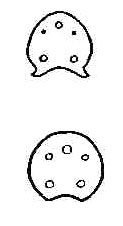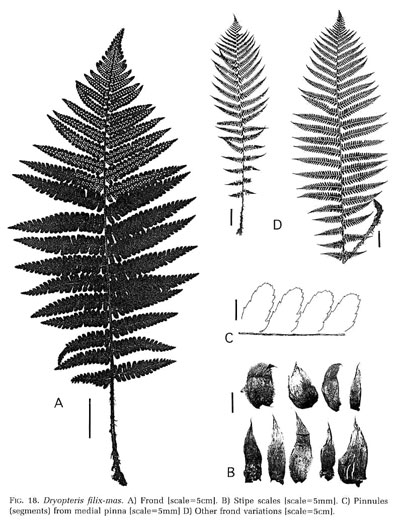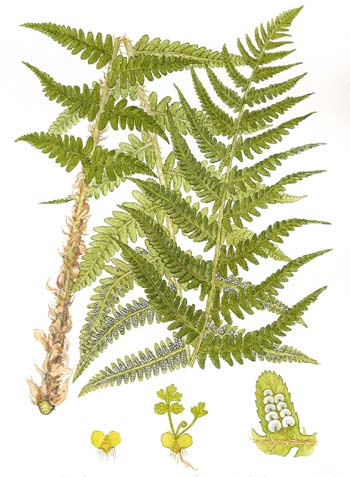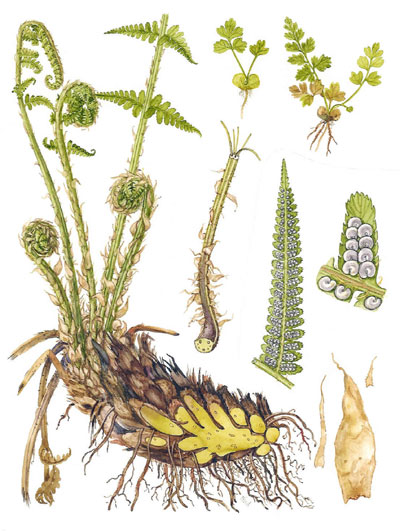| Dryopteris filix-mas | ||
Male fern | ||
|
Etymology
Latin: filix, fern + mas, male
Description
Rhizome: erect, stout, branching, covered with old stipe bases.
Frond: 120 cm high by 25 cm wide, deciduous, monomorphic, erect to somewhat arching, blade/stipe ratio: 2:1 to 3:1. Stipe: grooved, straw-brown, scales pale brown, vascular bundles: 5 or 7 in a c-shaped pattern. Blade: pinnate-pinnatifid, almost 2-pinnate, rarely more, ovate-lanceolate, widest at the middle, herbaceous to somewhat leathery, mid green, scales thin out along the green rachis. Pinnae: 16 to 24 pair, lanceolate, straight to slightly curved upwards; basal pinnae ovate-lanceolate, much reduced; pinnules basal pinnules � same length as adjacent pinnules, basal lower pinnule and basal upper pinnule equal, fully attached to costa along the base; costae grooved above, continuous from rachis to costae; margins serrate; veins free, forked. Sori: round, in 1 row between midrib and margin, on the upper half of the frond, indusium: reniform, pale green at first, then whitish, then leaden-gray, then rusty brown, then shriveling, at a sinus, sporangia: black or dark brown, maturity: late summer to mid autumn. Culture
Habitat: the eastern North American variety appears only on calcareous soils, the European, Asian, and western North American variety most anywhere.
Distribution: North America, Europe, Asia.
Hardy to -30�C, USDA Zone 4.
Synonyms
Polypodium filix-mas L. Lastrea filix-mas (L.) C. Presl. Aspidium filix-mas (L.) Swartz Filix-Mas filix-mas Farwell Polystichum filix-mas (L.) Roth Tectaria filix-mas Cav. Thelypteris filix-mas Nieuwl. |
|
|
Notes
Compare to Dryopteris affinis which has the dark blotch at the base of the costa, and a yellowish-green, more leathery blade, more scaly stipes, golden scales, and usually smaller size.
Parents Dryopteris oreades and D. caucasica. This is larger than the first parent. It is distinguished from the second by a darker color to the blade and simply-serrate margins of the segments rather than the doubly-serrate margins of D. caucasica.
Compare to Dryopteris affinis which has the dark blotch at the base of the costa, and a yellowish-green, more leathery blade, more scaly stipes, golden scales, and usually smaller size.
Parents Dryopteris oreades and D. caucasica. This is larger than the first parent. It is distinguished from the second by a darker color to the blade and simply-serrate margins of the segments rather than the doubly-serrate margins of D. caucasica.

Dryopteris filix-mas. Five vascular bundles at both the base and apex of the stipe. Compare this to the seven (at the base) and five (above)�shown in Kirsten Tind's illustration. �Drawing from Ferns of Northeastern United States, Farida A. Wiley, 1936. |

Dryopteris filix-mas. �Illustration from The Cultivated Species of the Fern Genus Dryopteris in the United States, Barbara Joe Hoshizaki and Kenneth A. Wilson, American Fern Journal, 89, 1, (1999), with permission. |

Dryopteris filix-mas. a) frond, b) fertile pinnules. �Illustration by V. Fulford from Ferns and Fern Allies of Canada, William J. Cody and Donald M. Britton, 1989, � Agriculture Canada, used with permission. |

Dryopteris filix-mas. Frond, note stipe cross-section; gametophyte; sporeling; fertile pinnule. �Illustration from Scandinavian Ferns by Benjamin �llgaard and Kirsten Tind, Rhodos, 1993. |
